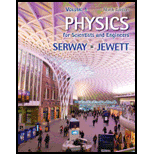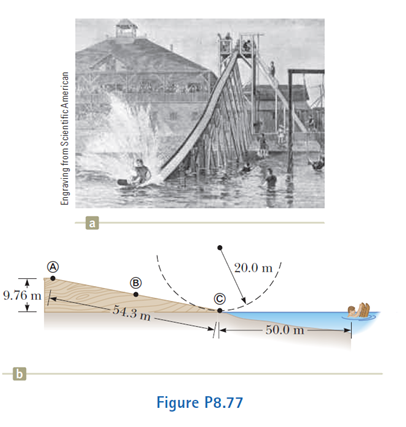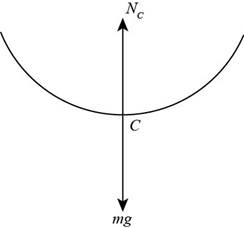
Concept explainers
Review. In 1887 in Bridgeport, Connecticut, C. J. Belknap built the water slide shown in Figure P8.77. A rider on a small sled, of total mass 80.0 kg, pushed off to start at the top of the slide (point Ⓐ) with a speed of 2.50 m/s. The chute was 9.76 m high at the top and 543 m long. Along its length, 72.5 small wheels made friction negligible. Upon leaving the chute horizon-tally at its bottom end (point ©), the rider skimmed across the water of Long Island Sound for as much as 50 m, “skipping along like a flat pebble,” before at last coming to rest and swimming ashore, pulling his sled after him. (a) Find the speed of the sled and rider at point © (b) Model the force of water friction as a constant retarding force acting on a particle. Find the magnitude of the

(a)
The speed of the sled and rider at point
Answer to Problem 8.77AP
The speed of the sled and rider at point
Explanation of Solution
Given info: The speed at point
The formula to calculate the kinetic energy at point
Here,
The formula to calculate the initial gravitational potential energy at point
Here,
The formula to calculate the gravitational potential energy at point
Here,
The formula to calculate the kinetic energy at point
Here,
The formula to calculate the energy at point
Here,
Substitute
The formula to calculate the energy at point
Here,
Substitute
Apply the law of conservation of energy at point
Here,
Substitute
Rearrange the above formula for
Substitute
Take the approximation.
Conclusion:
Therefore, the speed of the sled and rider at point
(b)
The magnitude of the friction force the water exerts on the sled.
Answer to Problem 8.77AP
The magnitude of the friction force the water exerts on the sled is
Explanation of Solution
Given info: The speed at point
The free body diagram is shown below.

Figure II
The formula to calculate the work done by the friction force at point
Here,
The formula to calculate the energy at point
Here,
Substitute
The formula to calculate the energy at point
Here,
Substitute
Apply the law of conservation of energy at point
Here,
Substitute
Rearrange the above formula for
Substitute
Thus, the value of work done by the frictional force is
From the above figure, the displacement is
Substitute
Thus, the frictional force acts on point
The formula to calculate the normal force is,
Here,
Substitute
Thus, the value of normal force is
The formula to calculate the magnitude of the force the water exerts on the sled is,
Here,
Substitute
Conclusion:
Therefore, the magnitude of the friction force the water exerts on the sled is
(c)
The magnitude of the force the chute exerts on the sled at point
Answer to Problem 8.77AP
The magnitude of the force the chute exerts on the sled at point
Explanation of Solution
Given info: The speed at point
From the above figure,
The formula to calculate the force exerted by the weight of the chute is,
Here,
The formula to calculate the force acting at point
Here,
The acceleration is 0 at point
The formula to calculate the force at the point
Here,
Substitute
Substitute
Conclusion:
Therefore, the magnitude of the force the chute exerts on the sled at point
(c)
The magnitude of the force the chute exerts on the sled at point
Answer to Problem 8.77AP
The magnitude of the force the chute exerts on the sled at point
Explanation of Solution
Given info: The speed at point
From the above figure,
The formula to calculate the centripetal force exerted at point
Here,
The formula to calculate the weight of chute at point
Here,
The formula to calculate the force at the point
Here,
Substitute
Substitute
Conclusion:
Therefore, the magnitude of the force the chute exerts on the sled at point
Want to see more full solutions like this?
Chapter 8 Solutions
Physics for Scientists and Engineers, Volume 1
- The 10-lb weight is supported by the cord AC and roller and by the spring that has a stiffness of k = 10 lb/in. and an unstretched length of 12 in. as shown in. Part A Determine the distance d to maintain equilibrium. Express your answer in inches to three significant figures. 節 ΕΠΙ ΑΣΦ d = *k J vec 5 t 0 ? d C A in. 12 in. Barrow_forwardThe members of a truss are connected to the gusset plate as shown in . The forces are concurrent at point O. Take = 90° and T₁ = 7.5 kN. Part A Determine the magnitude of F for equilibrium. Express your answer to three significant figures and include the appropriate units. F = Value Submit Request Answer Part B 0 ? Units Determine the magnitude of T2 for equilibrium. Express your answer to three significant figures and include the appropriate units. ? T₂ = Value Units T₁ Carrow_forwardpls help on botharrow_forward
- pls helparrow_forwardpls helparrow_forward6. 6. There are 1000 turns on the primary side of a transformer and 200 turns on thesecondary side. If 440 V are supplied to the primary winding, what is the voltageinduced in the secondary winding? Is this a step-up or step-down transformer? 7. 80 V are supplied to the primary winding of a transformer that has 50 turns. If thesecondary side has 50,000 turns, what is the voltage induced on the secondary side?Is this a step-up or step-down transformer? 8. There are 50 turns on the primary side of a transformer and 500 turns on thesecondary side. The current through the primary winding is 6 A. What is the turnsratio of this transformer? What is the current, in milliamps, through the secondarywinding?9. The current through the primary winding on a transformer is 5 A. There are 1000turns on the primary winding and 20 turns on the secondary winding. What is theturns ratio of this transformer? What is the current, in amps, through the secondarywinding?arrow_forward
- No chatgpt plsarrow_forwardWhat is the current, in amps, across a conductor that has a resistance of10 Ω and a voltage of 20 V? 2. A conductor draws a current of 100 A and a resistance of 5 Ω. What is thevoltageacross the conductor? 3. What is the resistance, in ohm’s, of a conductor that has a voltage of 80 kVand acurrent of 200 mA? 4. An x-ray imaging system that draws a current of 90 A is supplied with 220V. What is the power consumed? 5. An x-ray is produced using 800 mA and 100 kV. What is the powerconsumed in kilowatts?arrow_forwardՍՈՈՒ XVirginia Western Community Coll x P Course Home X + astering.pearson.com/?courseld=13289599#/ Figure y (mm) x=0x = 0.0900 m All ✓ Correct For either the time for one full cycle is 0.040 s; this is the period. Part C - ON You are told that the two points x = 0 and x = 0.0900 m are within one wavelength of each other. If the wave is moving in the +x-direction, determine the wavelength. Express your answer to two significant figures and include the appropriate units. 0 t(s) λ = Value m 0.01 0.03 0.05 0.07 Copyright © 2025 Pearson Education Inc. All rights reserved. 日 F3 F4 F5 1775 % F6 F7 B F8 Submit Previous Answers Request Answer ? × Incorrect; Try Again; 3 attempts remaining | Terms of Use | Privacy Policy | Permissions | Contact Us | Cookie Settings 28°F Clear 4 9:23 PM 1/20/2025 F9 prt sc F10 home F11 end F12 insert delete 6 7 29 & * ( 8 9 0 t = back Οarrow_forward
- Part C Find the height yi from which the rock was launched. Express your answer in meters to three significant figures. Learning Goal: To practice Problem-Solving Strategy 4.1 for projectile motion problems. A rock thrown with speed 12.0 m/s and launch angle 30.0 ∘ (above the horizontal) travels a horizontal distance of d = 19.0 m before hitting the ground. From what height was the rock thrown? Use the value g = 9.800 m/s2 for the free-fall acceleration. PROBLEM-SOLVING STRATEGY 4.1 Projectile motion problems MODEL: Is it reasonable to ignore air resistance? If so, use the projectile motion model. VISUALIZE: Establish a coordinate system with the x-axis horizontal and the y-axis vertical. Define symbols and identify what the problem is trying to find. For a launch at angle θ, the initial velocity components are vix=v0cosθ and viy=v0sinθ. SOLVE: The acceleration is known: ax=0 and ay=−g. Thus, the problem becomes one of…arrow_forwardPhys 25arrow_forwardPhys 22arrow_forward
 Principles of Physics: A Calculus-Based TextPhysicsISBN:9781133104261Author:Raymond A. Serway, John W. JewettPublisher:Cengage Learning
Principles of Physics: A Calculus-Based TextPhysicsISBN:9781133104261Author:Raymond A. Serway, John W. JewettPublisher:Cengage Learning Physics for Scientists and Engineers: Foundations...PhysicsISBN:9781133939146Author:Katz, Debora M.Publisher:Cengage Learning
Physics for Scientists and Engineers: Foundations...PhysicsISBN:9781133939146Author:Katz, Debora M.Publisher:Cengage Learning Physics for Scientists and EngineersPhysicsISBN:9781337553278Author:Raymond A. Serway, John W. JewettPublisher:Cengage Learning
Physics for Scientists and EngineersPhysicsISBN:9781337553278Author:Raymond A. Serway, John W. JewettPublisher:Cengage Learning Physics for Scientists and Engineers with Modern ...PhysicsISBN:9781337553292Author:Raymond A. Serway, John W. JewettPublisher:Cengage Learning
Physics for Scientists and Engineers with Modern ...PhysicsISBN:9781337553292Author:Raymond A. Serway, John W. JewettPublisher:Cengage Learning University Physics Volume 1PhysicsISBN:9781938168277Author:William Moebs, Samuel J. Ling, Jeff SannyPublisher:OpenStax - Rice University
University Physics Volume 1PhysicsISBN:9781938168277Author:William Moebs, Samuel J. Ling, Jeff SannyPublisher:OpenStax - Rice University College PhysicsPhysicsISBN:9781285737027Author:Raymond A. Serway, Chris VuillePublisher:Cengage Learning
College PhysicsPhysicsISBN:9781285737027Author:Raymond A. Serway, Chris VuillePublisher:Cengage Learning





